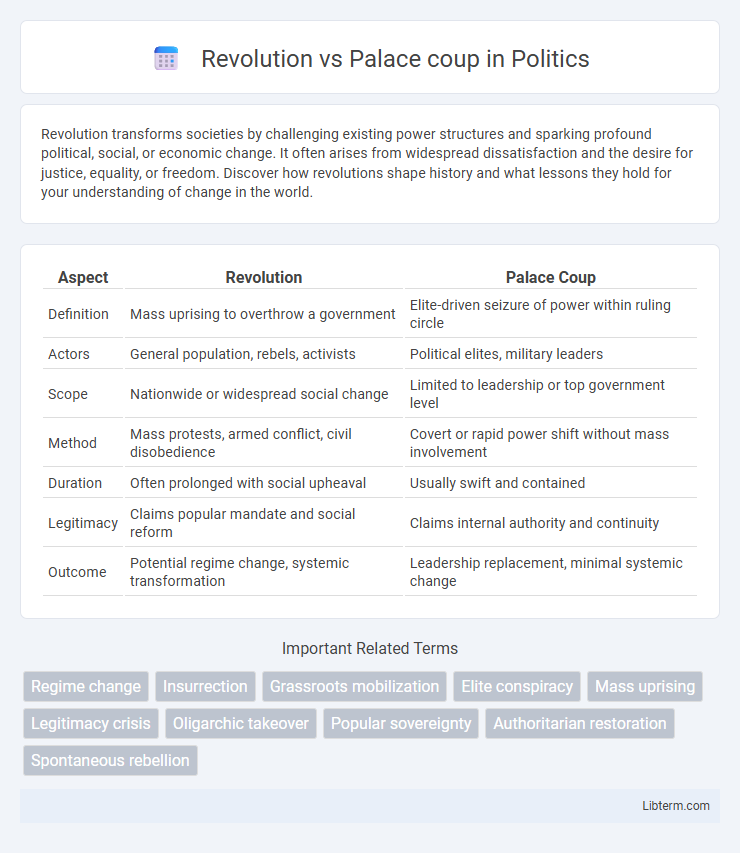Revolution transforms societies by challenging existing power structures and sparking profound political, social, or economic change. It often arises from widespread dissatisfaction and the desire for justice, equality, or freedom. Discover how revolutions shape history and what lessons they hold for your understanding of change in the world.
Table of Comparison
| Aspect | Revolution | Palace Coup |
|---|---|---|
| Definition | Mass uprising to overthrow a government | Elite-driven seizure of power within ruling circle |
| Actors | General population, rebels, activists | Political elites, military leaders |
| Scope | Nationwide or widespread social change | Limited to leadership or top government level |
| Method | Mass protests, armed conflict, civil disobedience | Covert or rapid power shift without mass involvement |
| Duration | Often prolonged with social upheaval | Usually swift and contained |
| Legitimacy | Claims popular mandate and social reform | Claims internal authority and continuity |
| Outcome | Potential regime change, systemic transformation | Leadership replacement, minimal systemic change |
Definitions: Revolution vs Palace Coup
A revolution is a fundamental and often violent overthrow of an existing government or social order, typically involving mass participation and aiming for broad systemic change. A palace coup is a sudden, non-popular seizure of power within an elite circle, usually confined to high-ranking officials or military leaders without widespread public involvement. Revolutions transform political structures extensively, whereas palace coups alter leadership with minimal disruption to the broader system.
Historical Contexts and Examples
Revolutions such as the French Revolution (1789) and the Russian Revolution (1917) often arise from mass popular uprising demanding radical social, political, or economic changes, fundamentally redefining state structures. In contrast, palace coups, exemplified by the overthrow of Tsar Peter III by Catherine the Great in 1762, are elite-driven events confined largely within royal courts or ruling classes, involving swift, insider power shifts without broad public participation. Both phenomena reflect different mechanisms of power transfer shaped by historical contexts of governance, social tension, and institutional stability.
Causes and Motivations
Revolutions typically arise from widespread social unrest, economic hardship, and demands for systemic change driven by popular mobilization, while palace coups are motivated by elite power struggles within ruling classes seeking to replace leadership without altering the broader political structure. Causes of revolutions include mass dissatisfaction with governance, inequality, and oppression, triggering collective action, whereas palace coups result from internal conflicts, ambition, or dissatisfaction among high-ranking officials or military leaders. Motivations in revolutions aim at comprehensive transformation of political, social, or economic systems, contrasting with palace coups that prioritize consolidating or redirecting power among existing elites.
Key Actors and Stakeholders
Revolution involves mass mobilization of citizens, key actors including revolutionary leaders, grassroots activists, and often the general populace seeking systemic change. In contrast, a palace coup is orchestrated by elite stakeholders such as high-ranking military officers, political insiders, or members of the ruling class aiming to seize power without broad public participation. The dynamics of these events pivot on whether power shifts through popular legitimacy or elite maneuvering within established institutions.
Methods of Power Transition
Revolutions typically involve mass mobilization, widespread protests, and often violent overthrow of an existing regime, emphasizing popular participation and radical change in government structure. Palace coups rely on secretive, elite-driven maneuvers within the ruling class or military, executing swift, low-profile seizures of power without broad public involvement. While revolutions reshape political systems through collective action, palace coups prioritize minimal disruption by confining power transitions to insiders.
Popular Participation and Support
Revolutions typically involve widespread popular participation and grassroots support, as large segments of the population actively seek radical changes in political, social, or economic structures. In contrast, palace coups generally occur within elite circles, with minimal public involvement, relying on a small group of insiders who orchestrate power shifts without broad-based support. The level of popular participation distinguishes revolutions as mass movements, whereas palace coups remain elite-driven events often insulated from public influence.
Outcomes and Long-term Effects
Revolutions often result in profound social and political transformations, establishing new governance structures and ideologies that reshape societies long-term. Palace coups typically produce immediate leadership changes without significantly altering underlying institutions, leading to short-term instability but often preserving the status quo. The lasting effects of revolutions include widespread reforms and shifts in public power dynamics, whereas palace coups may reinforce elite control and delay substantive change.
International Reactions and Implications
Revolutions often trigger widespread international attention due to their potential to inspire mass movements and alter geopolitical alliances, prompting diverse reactions ranging from sanctions to diplomatic support. Palace coups tend to provoke more subdued international responses, as they usually signify elite power shifts without broad societal change, yet they can destabilize regional security and affect foreign investments. Both dynamics impact international relations, with revolutions reshaping ideological blocs and palace coups influencing strategic calculations among global powers.
Legitimacy and Narrative Framing
Revolutions derive legitimacy from popular sovereignty and mass mobilization, framing their narrative around systemic change and the overthrow of entrenched power structures. Palace coups draw legitimacy primarily from elite consensus and insider power struggles, emphasizing stability and continuity within existing institutions. The narrative framing of revolutions often highlights grassroots empowerment, whereas palace coups focus on preserving order and elite interests.
Case Studies: Comparing Notable Instances
The 1917 Russian Revolution overthrew the Tsarist regime through mass mobilization and radical social change, contrasting sharply with the 1979 Iranian Palace Coup which was executed via elite power shifts within the monarchy's inner circle. The Arab Spring uprisings exemplify revolutionary movements driven by popular demands for democracy, whereas the 1936 Spanish Palace Coup by General Franco relied on military loyalty and political manipulation to dismantle the existing government. These case studies highlight the fundamental differences in scale, actors involved, and outcomes between revolutions and palace coups in political transitions.
Revolution Infographic

 libterm.com
libterm.com